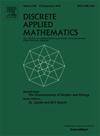On irredundance coloring and irredundance compelling coloring of graphs
IF 1
3区 数学
Q3 MATHEMATICS, APPLIED
引用次数: 0
Abstract
An irredundance coloring of a graph is a proper coloring admitting a maximal irredundant set all of whose vertices receive different colors. The minimum number of colors required for an irredundance coloring of is called the irredundance chromatic number of , and is denoted by . An irredundance compelling coloring of is a proper coloring of in which every rainbow committee (a set consisting of one vertex of each color) is an irredundant set of . The maximum number of colors required for an irredundance compelling coloring of is called the irredundance compelling chromatic number of , and is denoted by . We make a detailed study of , , derive bounds on these parameters and characterize extremal graphs attaining the bounds.
图的无冗余着色与无冗余强制着色
图G的无冗余着色是一种允许所有顶点都有不同颜色的最大无冗余集的适当着色。G的无冗余着色所需的最小颜色数称为G的无冗余色数,用χi(G)表示。G的无冗余强制着色是G的一种固有着色,其中每个彩虹委员会(由每种颜色的一个顶点组成的集合)是G的无冗余集。G的无冗余强制着色所需的最大颜色数称为G的无冗余强制着色数,用χirc(G)表示。我们详细研究了χi(G), χirc(G),导出了这些参数的界,并刻画了达到界的极值图。
本文章由计算机程序翻译,如有差异,请以英文原文为准。
求助全文
约1分钟内获得全文
求助全文
来源期刊

Discrete Applied Mathematics
数学-应用数学
CiteScore
2.30
自引率
9.10%
发文量
422
审稿时长
4.5 months
期刊介绍:
The aim of Discrete Applied Mathematics is to bring together research papers in different areas of algorithmic and applicable discrete mathematics as well as applications of combinatorial mathematics to informatics and various areas of science and technology. Contributions presented to the journal can be research papers, short notes, surveys, and possibly research problems. The "Communications" section will be devoted to the fastest possible publication of recent research results that are checked and recommended for publication by a member of the Editorial Board. The journal will also publish a limited number of book announcements as well as proceedings of conferences. These proceedings will be fully refereed and adhere to the normal standards of the journal.
Potential authors are advised to view the journal and the open calls-for-papers of special issues before submitting their manuscripts. Only high-quality, original work that is within the scope of the journal or the targeted special issue will be considered.
 求助内容:
求助内容: 应助结果提醒方式:
应助结果提醒方式:


